Metal threads used in embroidery are widely available, but type and quality vary among manufacturers and retailers. The embroidery market certainly has its share of “metal threads,” and you can pick up “metal” or metallic embroidery floss in just about any craft or sewing store. But goldwork often calls for specialty goods, so here’s a little blurb on a few of the “metal threads” (threads is probably the wrong word!) used in goldwork.
Gold passing is the topic of this particular article, and I’m looking primarily at two kinds: real gold and imitation gold.
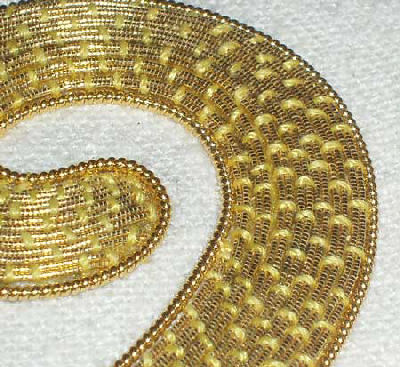
Before delving too far into this, you might want some background information on goldwork and how metal textiles are made, or you might want to take a look at some photos of a magnificent piece of goldwork.
Gold passing is often used to cover areas of design with smooth gold, by couching it. Above and below, you can see the Gold Passing Design from Berlin Embroidery Designs. This was the first goldwork I ever managed several years ago. This kit was perfect for getting me “into” goldwork and helping me learn how to use gold passing.
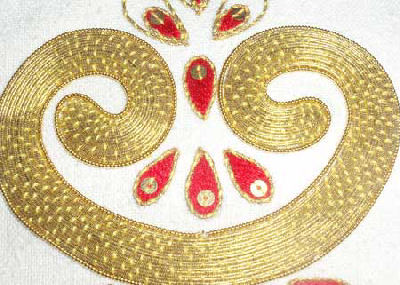
This is the majority of the gold passing design, and, for a first go at goldwork, I don’t think it’s too bad, though the mistakes seem a bit glaring: the twist around the red is couched incorrectly, the pearl purl is coming off in the center. But overall, this is what gold passing looks like when couched in a design. It gives a smooth filled gold look. There are different methods of couching – you can couch with gold thread as I did here, but you can also couch with colors, varying the distance between your couching to create a picture, as is done in the technique Or Nué. You can see a nice example of Or Nue at the Met.
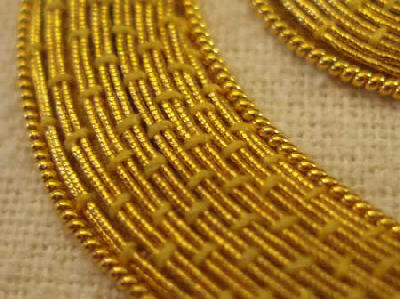
Here’s another close-up of the passing design, so you can see the couching, which is done over two gold passing threads at a time.
There are several sources for gold passing. Perhaps the most common source in the US is Kreinik, where you can purchase several types of real metals, including very limited sizes of passing, along with bullion, pearl purls, check purl, etc. They’re selection is very limited. I do not know (and they don’t mention it on their website) what the gold content is in these metals – whether or not they are gilt (a low content of gold), imitation (no gold), or 2%, which is, as I understand it, the highest content gold one can get in goldwork metals. Personally, I’m not that keen on Kreinik’s selection, and once upon a time, when I did order some metals from them, I was a little surprised by their very brassy yellow look.
Then, of course, there’s Berlin Embroidery Designs out of Canada, which is where I have purchased my 2% stuff, as well as her sampler goldwork kit. The 2% can get a little expensive. With the currency exchange rate, there is a slight difference between Tanja’s Canadian prices on her website and the US dollar. Still, there’s postage to consider, and this sort of balances out the exchange rate. Still, I like ordering from Tanja – I like the idea of supporting individual’s embroidery businesses.
My latest find for gold is the Japanese Embroidery Center in Georgia, from which I’ve been purchasing, testing, and comparing silk.
So here are my finds on gold passing, and some comparisons so you can see what the stuff is like.
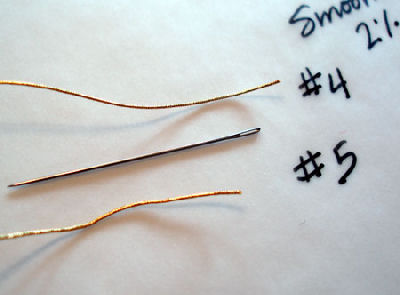
This is smooth passing, 2% from Berlin Embroidery Designs. The smallest Tanja Berlin carries is #4, which, as you can see by comparing it to the #10 embroidery needle, is fairly fine. There is a slight difference in size between the #4 and #5 both pictured above.
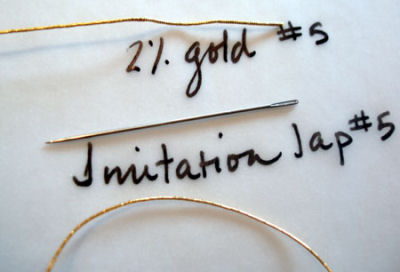
In the photo above, you see side by side the real gold passing (2%) in #5, and the Imitation Gold (Jap) from Japanese Embroidery Center, also #5.
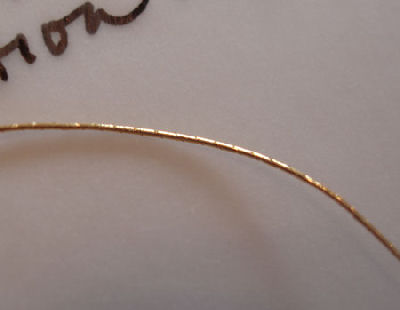
Above is a close-up on the Jap, and below is a close-up of the 2%. Notice that the “gold” that twists around the core on the Jap is in somewhat wider strips, whereas the gold that twists around the core in the 2% is much narrower, creating a much stiffer thread (like a fine wire).
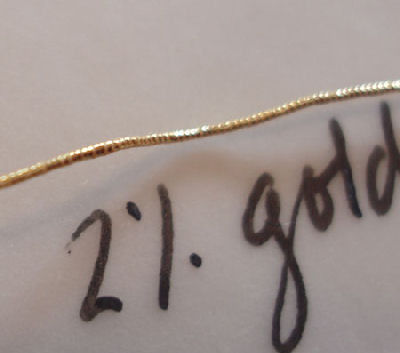
The Jap thread is more supple when compared to the 2%, probably because the outside “gold” is thinner and twisted around the core in wider strips.
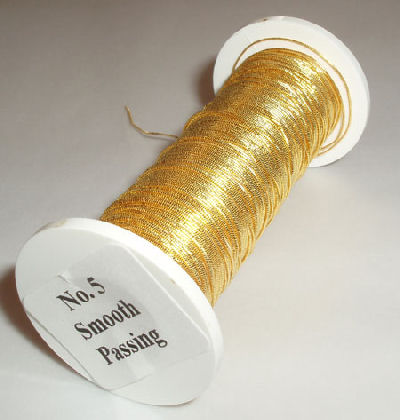
Tanja packages her smooth passing either in a small, archival save plastic bag, or on spools, depending on how much you order. I ordered 10 yards here, so it’s wound on a spool. The 2% is $3.00 (Canadian) / yard, so $30 Canadian for 10 yards.
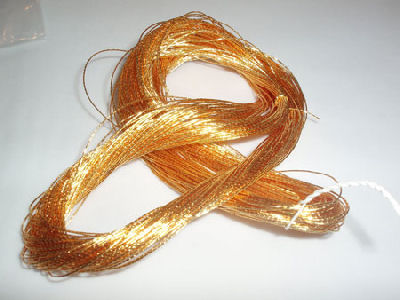
The imitation Jap comes in a hank, 40 meters for $7.00. That’s a considerable price difference! So you get about 43.75 yards for $7.00 (US), compared to 10 yards for about $25.50 US (as of today’s date).
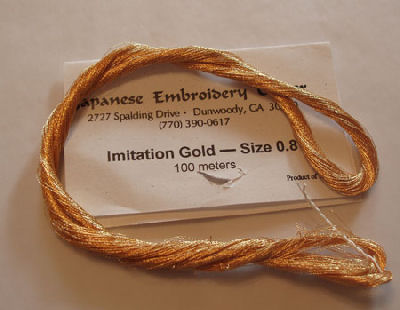
The imitation gold comes as small as size 0.8, which is sold in a hank of 100 meters, again, for $7.00. This stuff is super-fine, and can be used to embroider with (as in, passing through your fabric, not just couched on top).
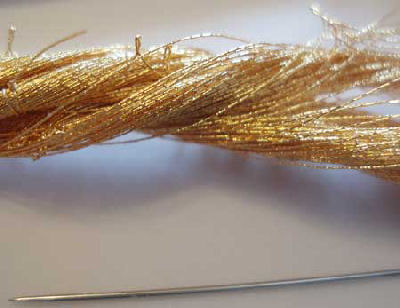
You can see here a close-up on the hank of Jap size 0.8, with a #10 embroidery needle for perspective. It’s teeny-tiny stuff!
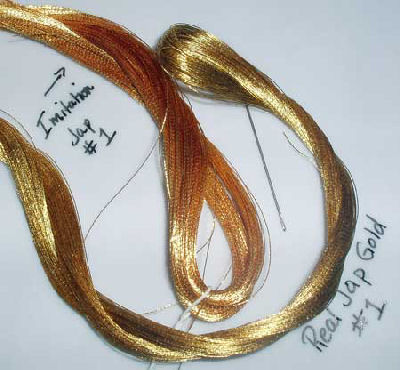
Now, Jap gold can also be had as “real” gold – that is, with real gold hammered and wound around the core thread. In the photo above, I’ve got size #1 in both imitation Jap and real gold. Notice the color difference: the imitation has a redder tone. The real gold from the Japanese Embroidery Center also comes in a hank: 50 meters for $33.00 (US). Real gold in #5 (like that above) comes in a 50 meter hank for $88.00. Again, it’s less expensive overall than the 2%. It’s more supple as well (like the imitation Jap), because of the method of manufacturing.
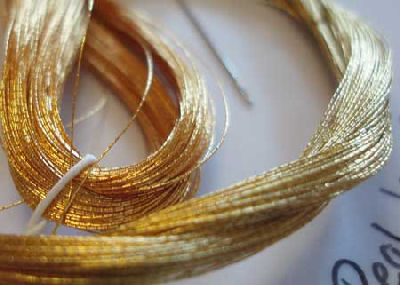
Here’s an up-close shot of the imitation Jap gold and the real gold, so you can see, again, the difference in color.
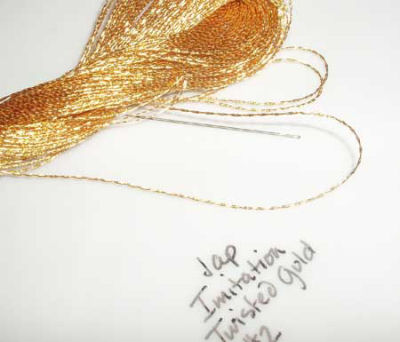
You can also purchase twisted gold for couching from the JEC. The twisted gold gives a different look to your project, because the twist reflects the light differently. This is imitation Jap as well.
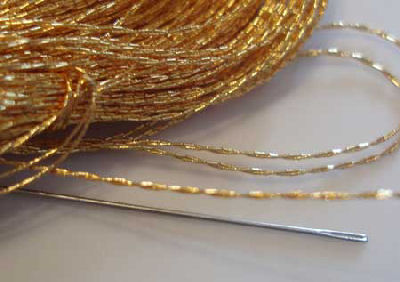
And, finally, here’s a close-up so you can see the size of the #2 twisted Jap gold in relation to the size of a #10 embroidery needle.
Why use real gold instead of imitation, or visa-versa? Well, real gold is “richer,” certainly. When you’re working on something of value, you might rest well in the knowlege that, with real gold, you’re working with the “best.” But, over time, real gold does tarnish – that is, it turns a bit darker. It’s not the gold itself tarnishing, because gold doesn’t tarnish – but to be worked, flattened, hammered, stretched, and retain strength, it has to be mixed with an alloy (sometimes silver), and this is what darkens. The imitation gold remains bright. But that “patina” (perhaps the wrong word!) or look of real gold over time is, I think, highly desirable on certain projects. As it darkens (not an ugly darkening, certainly), it looks richer. The real gold can also be cleaned by someone who knows how. The gilt or imitation golds remain a glaring bright, which takes away from the richer, aged look. This is just my opinion – I have certainly seen some beautiful needlework that was worked with imitation gold, the results of which are gorgeous. But…? I don’t know – what do YOU think about imitation vs. real gold? Does it just depend on the purpose of your project?
Next time I cover gold, I’ll give you some close-ups, comparisons, and resources for other types of metal used in goldwork. If you know of any further sources for different metals for goldwork, please let the rest of us know!







I wish I had seen your comparison pages about the various kinds of gold thread, before I started my own experiments! I’m basically stepping out into thin air with a lot of the beetle wing stuff, because historical examples are tough to get hold of; I did find some on the web. The one that I got the little doodling shape from (and interpreted with help from Tanja) is here.
I’m getting results I’m fairly pleased with (more work since these photos) – the wings are such amazing gleaming things! I want to embroider a hat.
“Real gold in #5 (like that above) comes in a 50 meter hank for $88.00. Again, it’s less expensive overall than the 2%.”
Why is the real gold less expensive than the 2%? Which has more gold in it?
Thanks for comparisons, they are very clear and helpful.
I would use cheaper gold for practicing and then use the more expensive kind for everything else. It would be very satisfying I would think. You know, like baseball players practicing with a extra-heavy bat. The nice thread would be so lovely to use after the cheaper kind.
-Christiana
hey mary
i recently started a project for a couple friends. while shopping for materials i came upon metallic threads. I loved the shinnyness and thought of all the possibilities, yet when i used it i didnt look so good. Are there stiches that you recommend that i do and dont use when using mettalic thread??? for example i used a red mettalic to outline a letter so that i could do stain, but now im thiking that the metal isnt such a good idea for satin stiching….. could you help me?
also could you explain how to send you pictures of projects. i would like to send you mine when down but couldnt figure out how..
Your the best mary…thank you!!! 🙂
Hi, Jules –
There’s a difference between metal threads and metallic threads. Metallic threads are the goldish or silverish threads you might pick up at a regular craft / sewing store, in the floss / DMC section. They aren’t made of real metal. Generally, they can be used just like regular floss, except they need a little extra care when stitching because they tend to fray up after passing through the fabric a lot. They also aren’t “smooth-looking” threads – they’re kind of rough, I think – so I don’t think they’d make a good satin stitch…
To send pictures, please drop me a line using the contact us link at the top of the page. I’ll reply, and then you can send photos. If you have an AOL e-mail address, though, it is likely that my e-mail will bounce back (for some reason, my e-mail address is generally rejected by AOL), so if you have an alternate e-mail address, you might want to use it (if you normally use AOL)
Good luck with your stitching!
MC
What the difference between the 2% gold thread and the japanese real gold. Does the realk gold contain a higher % of gold than the 2% ?
Hi.
I need to find a metallic thread for hand work. real metal.
If you can give me you e-mail i cand send you pictures about what kind of work i need to do.
best regards.
Hi, Carlos – here’s a link to my contact page: https://needlenthread.wpengine.com/contact Drop me a line and I’ll send you an e-mail! Thanks, Mary
another supplier of gold threads (recommended by Susie Pilkington at her workshop at Lancaster Cathedral)is Midori Embroidery at midori-embroidery.com. Thanks for your information – really helpful!
I am having a problem finding a source for colored metal thread. I know Berlin has 4 colors but looking in the book “Goldwork” by Hazel Everett, there are lots of colors that should be available. Can anyone assist?
Good afternoon,
Could you please advise if you or anyone you know actually does the real gold thread embroidery? I have 3 board member jackets that I require to have our logo placed on the jacket pocket.
I can email through a photo of the logo if required.
I look forward to hearing from you.
Kind regards,
Lana Thompson
Executive Assistant
Geraldton Fishermen’s Co-operative Ltd
Hi, Lana – thanks for your question. I see you’re in Australia. There are plenty of guilds and groups in Australia that could probably put you in touch with embroiderers a little closer to home who do this kind of work. You might try searching “embroidery guilds in Australia” or something similar to see if you can find one located close by. Another option is to contact a shop that specializes in embroidery supplies and classes – they may have some connections that take commissions. Try Country Bumpkin in The Adelaide area, for example. Hope that helps! – MC
Hi Mary,
Eagerly waiting for your tutorials for hope raised work.
Thanks so much for this post- it’s exactly what I was looking for!
I’ve pieced a small art quilt out of silk and would love to quilt it with a real gold thread- I am considering the #1 gold from the Japanese Embroidery company. In your opinion, would that be the best option to actually sew through the fabric (as opposed to couching it)? I’d hate to order it only to find it’s too wiry for a running stitch.
Thanks so much- I reference your blog all the time and find it so helpful!
I think sizes 1-3 from the JEC can be sewn through the fabric. You might contact them directly to be sure, but with size 1 (which is very fine), I don’t think there would be a problem.
Thanks!
Thank you so much for posting this article on goldwork threads! I’m trying to gather supplies to start my own goldwork adventure and have been at sea for a while trying to sort out all of the different threads! This article was immensely helpful, so much so that I think I’ll be placing an order tonight! 🙂
I knew nothing about gold work until I started reading your article. I am a “basic” cross stitcher. I read your columns because I like to pick up what ever I can about embroidery. I just have to comment about this particular article: which is the use of the word “Jap” to describe a type of thread. I had never heard of the types of thread used for this stitching, and have found that there is a thread referred to as “Japanese.” I’m assuming that this type of thread is Japanese in origin, in other works, from the country of Japan. When I came to the phrase “Jap thread,” my eyes ground to a halt. I was a bit shocked. I thought this abbreviation was always used as an insult, period, coming into common use at the end of World War II. (Maybe prior to that, I don’t know. I did Google the word to try to learn.) I am trying to learn if this word is universally accepted in the world of needlework. Or might it be one of those words whose time has come to be retired. Can’t it just be “Japanese thread?” I don’t intend to be accusatory. I enjoy your articles and admire your talent and knowledge. Just wondering…
Is gold braid and gold twist the same? My project (strawberry fields by kay stannis) calls for gold braid but I can’t find a source for it. I can find gold twist though.
Hi
I found some Japanese gold thread on etsy that was sold to me as either real silver with gold electroplated on top wrapped around a core or pure gold. I compared it to another seller’s product of gold thread. The wrapping of the other product does not burn when passed through a lighter flame, but the Japanese wrapping turns to very fine ash. I suspect I was sent cheap imitation, is this flame test enough to ask for a refund and complain to the etsy platform or is there some reason gold and silver would turn to ash in a lighter flame?
Hi, Angela – Japanese gold is made by fixing the gold and silver to paper, and then wrapping that paper around a silk core (usually silk, especially if it’s older Japanese thread). So it should turn to ash. If it is melting into something other than ash, then it isn’t on a silk core or mounted on paper. The gold itself is extremely fine. Imagine the lightest of gold leafs, for gold leafing – that’s the concept, pretty much. So it’s not going to turn into a lump of gold when burned. It’s going to burn with the paper, and the silk will burn and turn to ash, too. Well, the silk should turn to almost a kind of charcoal-ash “bead” that smells somewhat like burning hair and that, when touched, turns to ash. No Japanese gold is wound onto a core of pure gold – that wouldn’t work for an embroidery thread.
I know this was not your intention and never even occurred to you when writing this article, but “jap” is an old slur for Japanese people during WWII. Maybe abbr it as JT (Japanese Thread) instead? It was a little jarring when I came to this page looking for a comparison of the goldwork materials. :/
Do they sell any of these for embroidery machines? 30-40weight?
Hi, Kayla, Real metal threads are not used in embroidery machines. Instead, you’d look for synthetics, like lurex threads. Hope that helps!